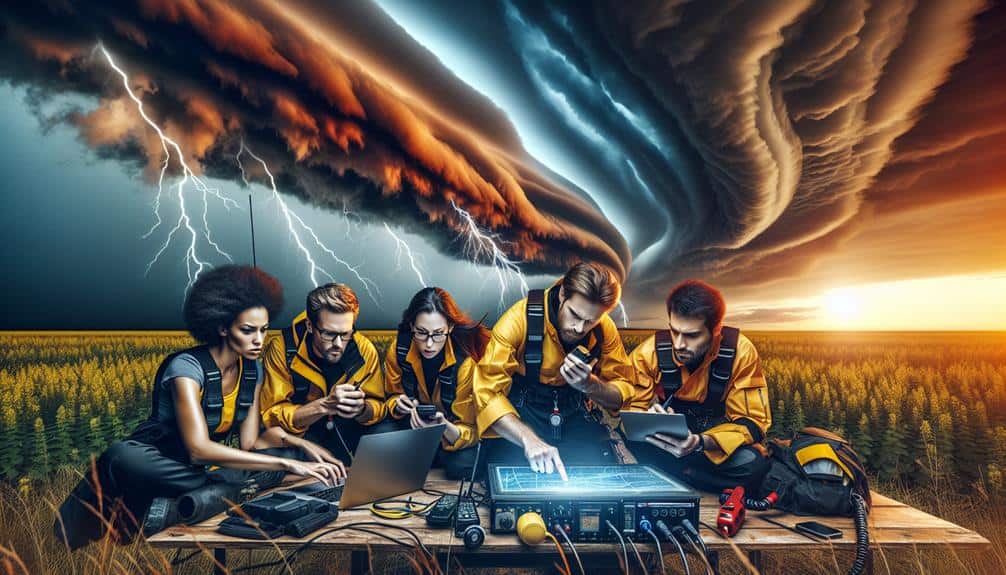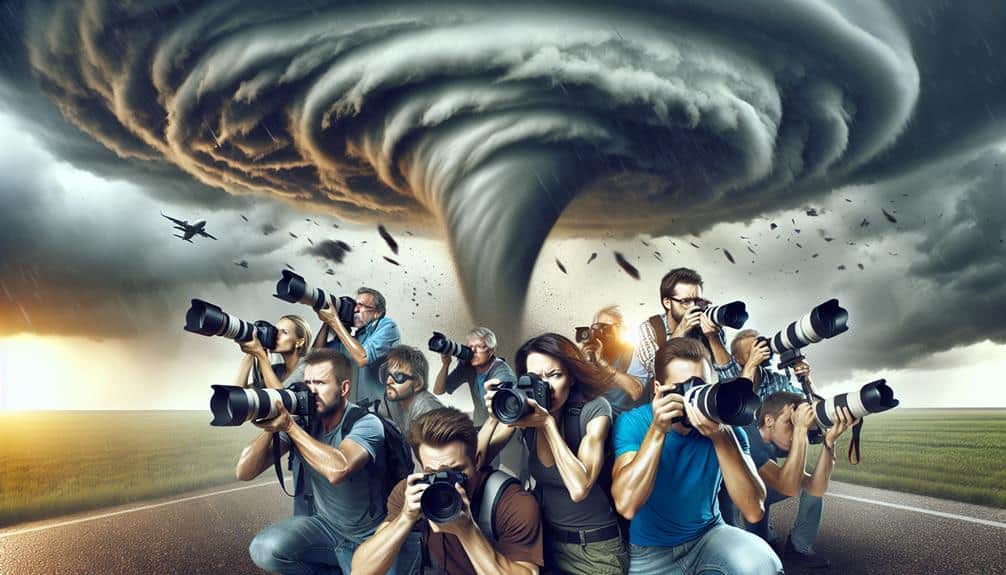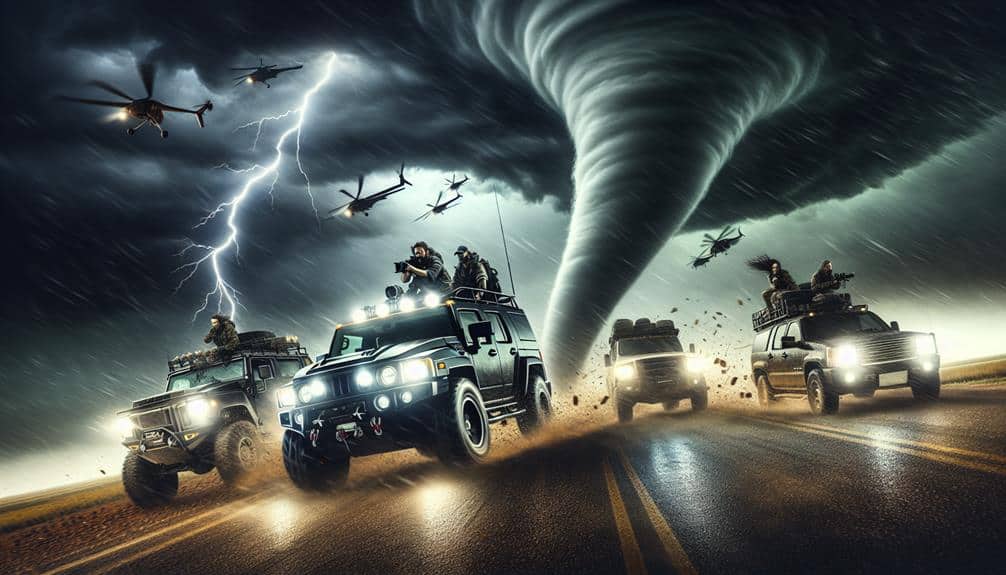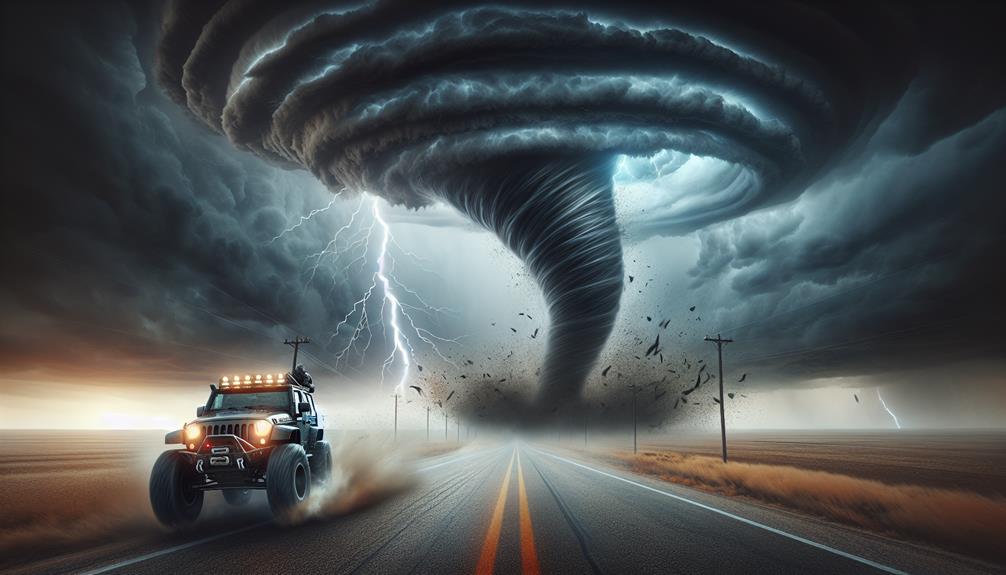When it comes to ethical storm chaser coverage, we need to prioritize several best practices. To begin, ensuring our safety protocols include dependable meteorological tools and clear communication with authorities. We must respect privacy by obtaining consent before capturing footage and treating sensitive data with care. Accuracy is essential, so we should avoid sensationalism and verify information through multiple channels. Providing context by analyzing historical weather patterns and regional vulnerabilities is important. Finally, effective collaboration with team members and local communities enhances our reporting. By following these steps, we contribute to responsible and informative storm chasing. Explore further for detailed insights.
Key Points
- Equip storm-chasing vehicles with essential safety gear and reliable meteorological tools.
- Obtain informed consent before capturing and using images or personal stories.
- Ensure accurate, community-centered reporting while avoiding sensationalist language.
- Validate information through thorough fact-checking and consulting multiple sources.
Prioritize Safety
In the realm of storm chasing, our primary focus must always be guaranteeing the safety of both the chasers and the public. To achieve this, we need to implement strict safety precautions and establish a strong emergency response plan. Data from the National Weather Service shows that adherence to safety protocols markedly reduces the risk of injury or fatality during storm events.
First, we must equip our vehicles with essential safety gear, including first aid kits, weather radios, and emergency beacons. Real-time weather data is vital, so we should use reliable meteorological software to track storm developments. Additionally, maintaining constant communication with local authorities enables us to stay informed about hazardous conditions and necessary evacuations.
We can't overlook the significance of having a detailed emergency response plan. This plan should include predefined escape routes, designated safe zones, and a communication strategy for notifying teammates and emergency services. By coordinating with local first responders, we can ensure a swift and efficient reaction to any critical situations that arise.
Ultimately, by prioritizing safety, we not only protect ourselves but also contribute to the overall safety and well-being of the communities we serve.
Respect Privacy
Respecting the privacy of individuals and communities affected by storms is essential to maintaining ethical standards in storm chaser coverage. We must recognize that storm events often leave people vulnerable and exposed, making it vital to adopt a sensitive approach. Our primary goal is to document these events without infringing on the personal spaces of those who are already facing significant distress.
When we capture footage or take photos of affected areas, we should always seek to obtain permission from individuals who are visibly identifiable. This guarantees that we respect their right to privacy and avoid any potential exploitation. Data indicates that communities are more likely to cooperate when they feel their privacy is respected, leading to more accurate and thorough coverage.
Additionally, respecting privacy extends to how we handle and share our collected data. We must be cautious about revealing specific locations or personal details that could potentially harm or re-traumatize individuals.
Obtain Consent
Obtaining explicit permission from individuals before capturing or using their images guarantees we respect their rights and maintain ethical reporting standards. When we encounter people affected by severe weather, it's important to engage in an informed consent process. This means clearly explaining to individuals how their images or stories will be used, making sure they fully understand and agree.
Ethical considerations demand we prioritize people's autonomy and privacy. A study by the American Psychological Association found that respecting consent increases trust and cooperation. In storm-chasing scenarios, where emotions run high, obtaining informed permission fosters a respectful environment.
We should use clear, straightforward language to request consent, avoiding technical jargon that could confuse. According to the National Press Photographers Association, gaining explicit permission not only aligns with ethical guidelines but also enhances the credibility of our work.
Data-driven approaches show that audiences are more receptive to ethically sourced content. A 2020 survey by the Reuters Institute indicated that 63% of respondents trust media outlets that explicitly follow ethical standards. By obtaining informed permission, we ensure our coverage is both ethical and credible, reinforcing the integrity of our storm-chasing efforts.
Avoid Sensationalism
We must prioritize accurate reporting to guarantee the integrity of our coverage.
By respecting affected communities and avoiding fearmongering language, we can maintain public trust and provide useful information.
Sensationalism not only distorts reality but also undermines our credibility as storm chasers.
Prioritize Accurate Reporting
Guaranteeing our storm coverage remains grounded in factual, data-backed reports helps maintain public trust and avoids the pitfalls of sensationalism. By prioritizing data analysis and forecast accuracy, we provide our audience with reliable information. This precision in reporting empowers individuals to make informed decisions, aligning with their desire for freedom and personal responsibility.
We rely heavily on the latest meteorological data and predictive models to secure our reports are both accurate and current. Data analysis allows us to track storm patterns, predict potential impacts, and offer timely warnings. This scientific approach reduces the risk of exaggerated claims and focuses on delivering the facts as they are.
Forecast accuracy is another cornerstone of our ethical coverage. By cross-referencing multiple data sources and using advanced forecasting tools, we minimize errors and improve the reliability of our reports. When we present information that's accurate and verifiable, we help the public prepare effectively without causing unnecessary panic.
Respect Affected Communities
Respecting impacted communities demands that we approach storm coverage with sensitivity and a commitment to factual reporting, avoiding any tendency toward sensationalism. This means we must engage with local residents to understand the full context of the storm's impact. Community engagement is key to producing accurate, respectful coverage.
By interviewing locals and gathering firsthand accounts, we can paint a genuine picture of the situation without resorting to exaggeration.
Cultural sensitivity is equally vital. Every community has unique traditions and values that should be honored in our reporting. For example, in areas with a strong sense of community, it's important to highlight collective efforts and resilience rather than solely focusing on destruction. This approach not only respects the impacted communities but also provides a more balanced view of the event.
Data supports that sensationalist reporting can lead to increased anxiety and misinformation. A study from the Journal of Contingencies and Crisis Management found that factual, community-centered reporting during crises resulted in higher trust and better public response.
Thus, our obligation is to present information that empowers the audience, fostering a sense of autonomy and trust. Let's aim for ethical coverage that prioritizes accuracy, community engagement, and cultural sensitivity.
Avoid Fearmongering Language
In storm coverage, it's important to avoid fearmongering language that could exacerbate public anxiety and spread misinformation. When we sensationalize events, we not only distort the facts but also amplify the emotional impact on viewers. This can lead to heightened public perception of danger, which may not align with the actual risk levels.
Using data-driven analysis, we must present information accurately and avoid hyperbolic statements. For instance, rather than saying, 'This storm will devastate the region,' we can provide specific metrics such as wind speeds, rainfall predictions, and affected areas. This allows individuals to make informed decisions without unnecessary panic.
Moreover, the language we choose directly influences the public's response. By refraining from using terms like 'catastrophic' or 'apocalyptic' unless absolutely warranted, we help maintain a balanced perspective. This not only respects the audience's need for clear and precise information but also mitigates undue stress and anxiety.
Ultimately, our goal is to empower the public with accurate, actionable information rather than inciting fear. Ethical storm coverage prioritizes transparency and objectivity, ensuring that we contribute positively to the public's understanding and preparedness.
Verify Information

Accurate storm chaser coverage hinges on meticulous verification of all gathered information to guarantee the reliability of our reports. To maintain the highest standards, we must fact check sources and cross reference data. This secures that our audience receives accurate and trustworthy information, free from misinformation or exaggerated claims.
To achieve this, we should:
- Fact check sources: Verify the credibility of the information providers and secure they've a proven track record.
- Cross reference data: Compare collected data with other reliable sources to confirm accuracy.
- Use multiple channels: Gather information from various platforms, including social media, official weather services, and local reports.
- Validate visual evidence: Secure that images and videos are authentic and correspond to the reported event.
Provide Context
When providing context in our storm chaser coverage, we need to take into account historical weather patterns, geographic vulnerability insights, and community preparedness levels. These factors help us present a detailed and accurate picture of the situation.
Historical Weather Patterns
To understand the impact of storm chaser coverage, we must analyze historical weather patterns that reveal trends and anomalies over decades. By studying these patterns, we can better grasp the implications of climate change and enhance disaster response strategies. Historical data provides an objective foundation for predicting future weather events and refining our coverage practices.
Key findings from historical weather patterns include:
- Increasing Frequency of Extreme Weather Events: Data shows a rise in the number of hurricanes, tornadoes, and severe storms, likely influenced by climate change.
- Shifts in Storm Paths: Historical records indicate that storm trajectories are evolving, affecting new regions and challenging existing disaster response plans.
- Temperature Anomalies: There are significant deviations from historical temperature norms, which impact storm formation and intensity.
- Precipitation Changes: Variations in rainfall and snowfall patterns contribute to flooding and drought conditions, complicating emergency responses.
Geographic Vulnerability Insights
Understanding geographic vulnerability is crucial for tailoring storm chaser strategies to areas most at risk of severe weather impacts. By analyzing data on regional weather patterns, population density, and infrastructure resilience, we can prioritize our efforts where they're most needed. This approach ensures that our storm chasing activities contribute meaningfully to disaster response rather than merely documenting events.
Geographic vulnerability assessments are informed by climate change adaptation strategies. These strategies account for shifting weather patterns that increase the frequency and intensity of storms in certain regions. For instance, coastal areas might be more prone to hurricanes, while the central U.S. could see more tornadoes. By using advanced meteorological data and geographic information systems (GIS), we can identify and focus on these high-risk zones.
Incorporating local infrastructure and socioeconomic factors into our analysis allows us to understand how different communities will be impacted. This holistic view enables us to provide real-time data that can be critical for emergency services and local authorities. This way, our role transcends mere observation; we become an integral part of a proactive disaster response network.
Ethical storm chasing isn't just about the thrill of the chase but about making a tangible difference in climate change adaptation and community resilience.
Community Preparedness Levels
Evaluating community readiness levels involves examining how well-equipped different regions are to handle severe weather events through emergency planning, resource availability, and public awareness programs. By appraising these factors, we can determine the effectiveness of disaster response strategies and identify areas that need improvement.
When we look at readiness, we consider:
- Emergency planning: Does the community have a robust and up-to-date emergency plan tailored to their specific risks? This includes evacuation routes, shelters, and communication strategies.
- Resource availability: Are there sufficient resources such as emergency kits, medical supplies, and trained personnel ready to respond to a disaster?
- Public awareness programs: How well-informed are the residents about potential risks and the actions they should take during an emergency?
- Community drills: Do local authorities regularly conduct drills and simulations to ensure everyone knows their role in a disaster response?
Collaborate Responsibly

When storm chasers collaborate responsibly, they enhance data accuracy and promote safety for all involved. To collaborate effectively, we must prioritize communication and data sharing among team members and other storm chasers in the vicinity. This approach ensures that everyone has the latest information, reducing the risk of redundant efforts and potential conflicts.
Ethical journalism, within this context, means verifying and cross-referencing data before dissemination to the public, guaranteeing that our reports are both reliable and timely.
We can leverage technology platforms such as real-time GPS tracking and dedicated communication channels to maintain situational awareness. These tools help us avoid overcrowded areas and dangerous conditions, improving our chances of capturing valuable data while remaining safe.
Additionally, integrating our findings with meteorological agencies can provide a richer, more accurate picture of storm behavior, contributing to broader scientific research and public awareness.
Responsible collaboration also means respecting the local communities affected by severe weather. We should aim to minimize our footprint, avoiding interference with emergency services and local residents. By adhering to these principles, we uphold the integrity of our work and contribute to a more informed and safer society.
Frequently Asked Questions
How Can Storm Chasers Effectively Use Social Media During Coverage?
We can maximize our social media engagement by following proper etiquette, providing real-time updates, and ensuring active audience interaction. This approach keeps followers informed and engaged, fostering a community that values accurate storm coverage.
What Are the Legal Implications of Storm Chasing?
While we crave the thrill of the chase, legal responsibilities and safety regulations can't be overlooked. Balancing our freedom with adherence to laws guarantees we're not endangering lives or violating restrictions. Let's stay informed and safe.
How Should Storm Chasers Handle Encounters With Wildlife?
When we encounter wildlife during storm chasing, we must prioritize ethical considerations. Maintain a safe distance, avoid disturbing animals, and document encounters responsibly. This guarantees our freedom to chase while respecting nature's integrity.
What Type of Training Is Recommended for Aspiring Storm Chasers?
We recommend aspiring storm chasers undergo hands-on simulations and complete meteorology courses. These provide practical experience and technical knowledge, ensuring we're prepared for real-world scenarios and can make data-driven decisions while maintaining our freedom in the field.
How Can Storm Chasers Contribute to Scientific Research?
We can contribute to scientific research by focusing on data collection and meteorological analysis. Our collaboration with researchers guarantees accurate, timely data, providing freedom to explore and understand storm behaviors more effectively and safely.


